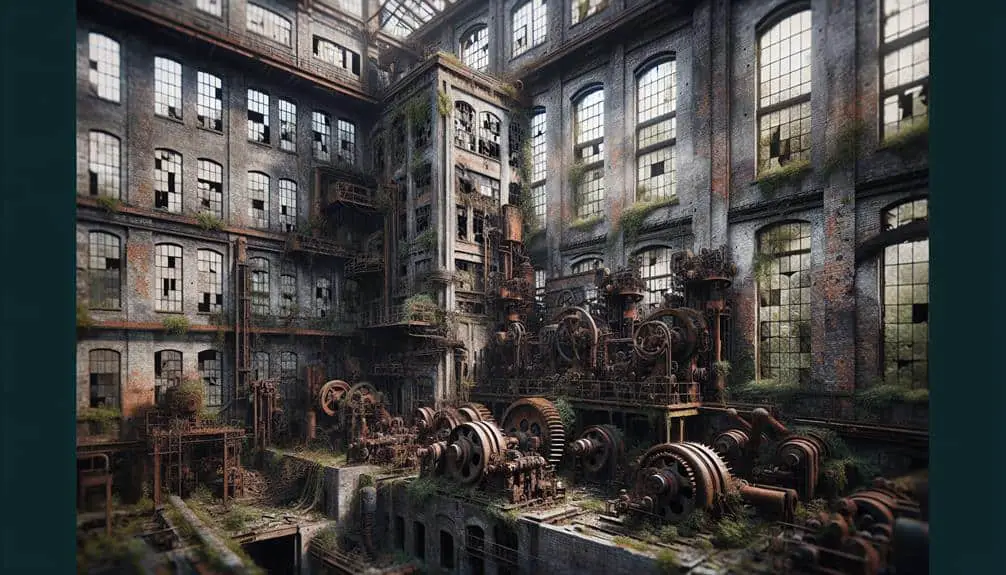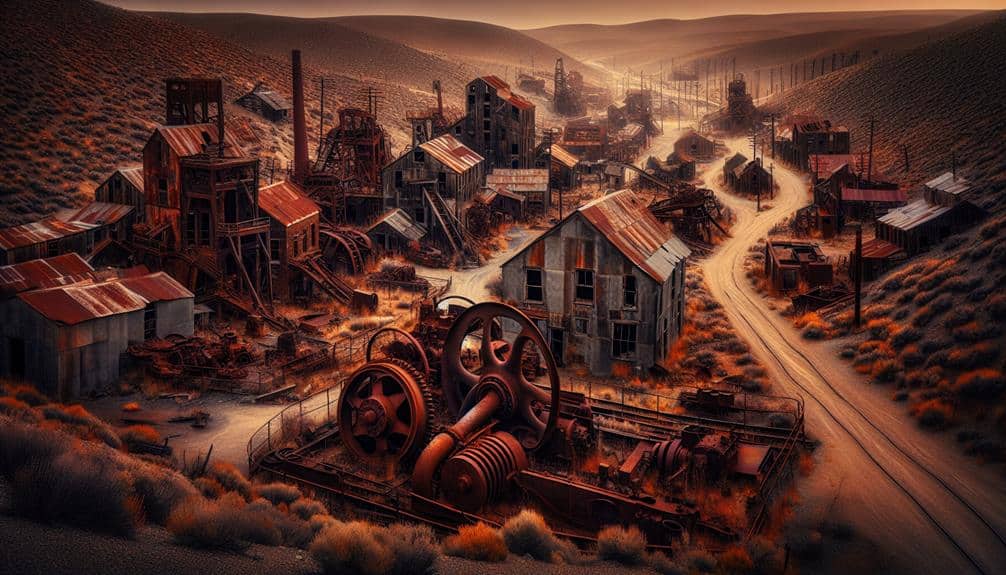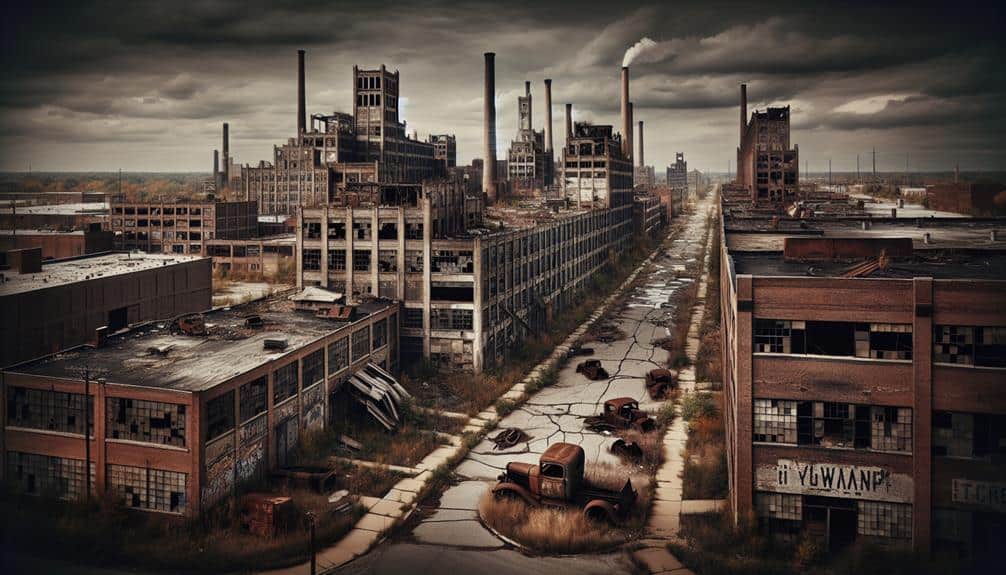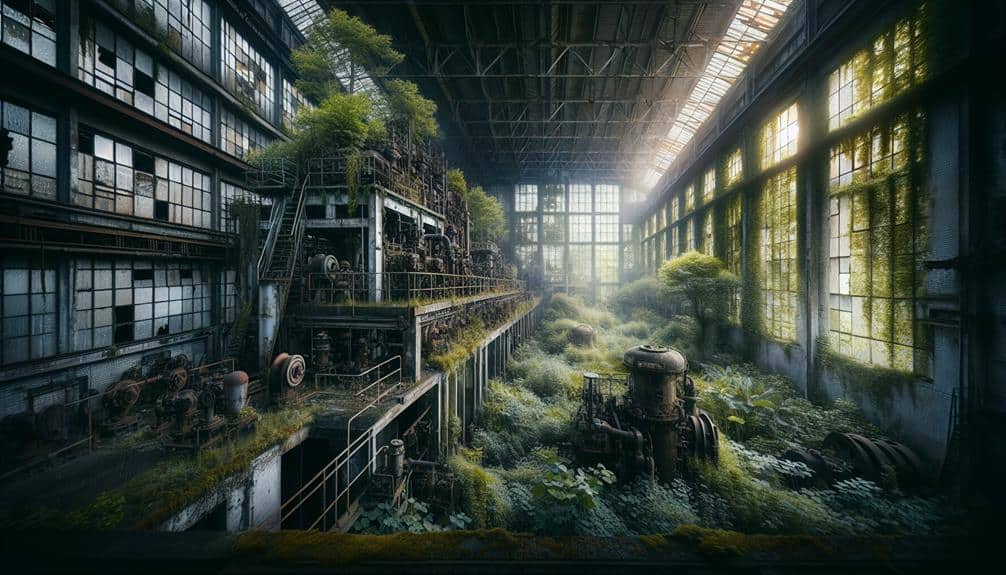During the United States Industrial Revolution, the rapid expansion of industries led to the creation of ghost towns. As industries boomed, urbanization patterns changed drastically, causing overcrowding and poor living conditions in urban centers. Technological advancements like steam power and mechanized farming also played a role by decreasing the need for laborers. This, combined with economic fluctuations, led to a cycle of prosperity and downturns, impacting community well-being. Environmental degradation resulting from industrial activities further pushed residents to abandon their homes. The consequences of this revolution reshaped landscapes and communities to a large extent. More insights await on the factors contributing to ghost town emergence.
Key Points
- Rapid industrial expansion led to the development of ghost towns due to sudden growth and decline.
- Technological advancements like steam power and mechanized farming reduced the need for labor in these towns.
- Labor migration influx resulted in overcrowding, inadequate housing, and exploitation in industrial areas.
- Economic boom and bust cycles caused market fluctuations and investment speculation, impacting town stability.
- Environmental degradation from industrial activities led to ecosystem destruction, forcing residents to abandon toxic environments.
Rapid Industrial Expansion Impact
The rapid expansion of industries during the US Industrial Revolution left a lasting impact on the landscape, economy, and communities, shaping the development of ghost towns. Urbanization patterns shifted drastically as industries boomed, drawing people from rural areas to towns and cities in search of employment opportunities. This influx of individuals led to overcrowding in urban centers, creating challenges such as inadequate housing and poor living conditions.
Social transformation was a key aspect influenced by this rapid industrial expansion. The traditional social fabric of rural communities was disrupted as people migrated to urban areas, seeking work in factories and mills. This shift brought about changes in social norms, family structures, and community dynamics. The newfound focus on industrial production also altered the way people viewed work and labor, leading to shifts in societal values and priorities.
As urbanization patterns evolved and social transformations took place, the landscape of America changed significantly, laying the groundwork for the emergence of ghost towns as industries rose and fell, leaving once-thriving communities abandoned in their wake.
Technological Advancements Effects
Amidst the industrial revolution in the US, technological advancements wielded profound effects on the landscape, economy, and social fabric of communities, ultimately shaping the trajectory of ghost town emergence. The rapid adoption of new technologies like steam power and mechanized farming led to significant social transformations. Traditional agricultural communities shifted towards industrial hubs, causing demographic changes and altering the social dynamics within these areas. Additionally, the implementation of advanced machinery and production methods resulted in the need for fewer laborers, leading to shifts in employment patterns and contributing to the decline of certain towns.
Furthermore, infrastructure changes played a critical role in the evolution of ghost towns during the industrial revolution. The development of railroads and canals facilitated the movement of goods and people across vast distances, creating new economic opportunities but also rendering some settlements obsolete. As industries relocated to be closer to transportation hubs or natural resources, towns that were once thriving centers of production found themselves abandoned, illustrating the profound impact of technological advancements on community sustainability.
Labor Migration Consequences
As labor migration surged during the US industrial revolution, communities experienced significant consequences reshaping their social and economic landscapes. The influx of workers seeking employment in factories and mines led to labor exploitation, where workers endured long hours, low wages, and unsafe working conditions. This exploitation not only affected the physical well-being of workers but also strained community dynamics as labor disputes and strikes became more common.
Moreover, the large-scale migration of workers resulted in population displacement within rural areas as people moved to urban centers in search of job opportunities. This mass movement of individuals contributed to the rapid growth of cities, putting pressure on infrastructure and housing availability. As a consequence, overcrowding and inadequate living conditions became prevalent issues in many urban areas, further exacerbating social tensions.
Economic Boom and Bust Cycle
Following the influx of workers and the labor exploitation experienced during the US industrial revolution, the Economic Boom and Bust Cycle played a significant role in shaping the fate of these communities.
- Market Fluctuations: The rapid industrialization led to volatile market conditions, causing sudden shifts in demand for goods and services. This instability often resulted in job displacement as factories struggled to adapt to changing market forces.
- Investment Speculation: During periods of economic prosperity, investment speculation ran rampant in these burgeoning industrial towns. However, this speculative bubble eventually burst, leading to widespread economic downturns that devastated the local economies.
- Cycles of Prosperity and Recession: The erratic nature of the economic boom and bust cycle meant that these ghost towns experienced cycles of prosperity followed by sharp downturns. This rollercoaster effect created uncertainty and instability for residents and businesses alike.
- Impact on Community Well-being: The constant oscillation between economic highs and lows took a toll on the overall well-being of the communities, leading to social unrest, poverty, and a sense of disillusionment among the populace.
Environmental Degradation Ramifications
Environmental degradation in these ghost towns resulted in long-lasting consequences for both the ecosystems and the residents, fundamentally altering the landscape and quality of life. The ecological devastation caused by unchecked industrial activities led to polluted water sources, deforestation, and soil contamination. As a result, wildlife habitats were destroyed, and once-thriving ecosystems were disrupted, impacting biodiversity for generations to come.
Moreover, the community displacement that ensued from environmental degradation further exacerbated the situation. Residents were forced to abandon their homes due to the toxic environments, leaving behind a shell of a town that once flourished with life and activity. This displacement not only shattered social ties but also left a void in the fabric of these towns, where memories of vibrant communities were overshadowed by the desolate aftermath of industrial exploitation.
Frequently Asked Questions
What Role Did Government Policies Play in the Creation of Industrial Revolution Ghost Towns in the United States?
So, you're curious about how government policies influenced those eerie ghost towns from the Industrial Revolution, huh? Well, let's chat about government intervention and labor disputes – they were like the puppeteers pulling the strings of those deserted towns.
How Did the Cultural and Social Landscape of These Ghost Towns Change as a Result of Industrialization?
As industrialization swept through, the cultural adaptation in ghost towns was profound. Society transformed rapidly, with once thriving communities fading into shadows. People dispersed, traditions shifted, and the social fabric unraveled, leaving behind echoes of a bygone era.
Were There Any Efforts Made to Revitalize or Repurpose These Abandoned Industrial Sites in the Aftermath of Their Decline?
Efforts to breathe life into forgotten industrial relics varied. Revitalization initiatives aimed to transform desolate factories into vibrant spaces. Repurposing projects reimagined abandoned sites, sparking hope in the shadow of decay, showcasing resilience through innovation and adaptation.
What Impact Did the Industrial Revolution Ghost Towns Have on Neighboring Communities and Economies?
The industrial revolution ghost towns had a significant impact on neighboring communities. Economic consequences were severe as jobs vanished, businesses closed, and populations dwindled. The ripple effect on these areas was profound and long-lasting.
How Did the Decline of These Industrial Towns Affect the Mental and Physical Health of Their Former Residents?
As the industrial towns declined, the mental health of former residents suffered from the loss of community and purpose. Physical health deteriorated due to limited access to healthcare and increased stress from economic hardships.



